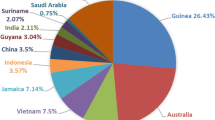Abstract
In this research, the effects of different stirring speeds on the molten pool flow and the internal flow field of the molten pool were studied by water simulation and numerical simulation. The software ANSYS ICEM, ANSYS FLUENT, and Tecplot 360 were used to model, compute, and post-process, respectively. A physical model made of plexiglass was used to conduct the water simulation experiment. The advantages of vortex smelting reduction were analyzed theoretically and verified by high-temperature experiments. At a stirring speed of approximately 150 rpm, vortex smelting reduction was not only beneficial to the uniform dispersion of the material particles in the molten pool, increasing the reduction reaction rate, but it was also beneficial to the separation of slag and metal. The experimental results confirmed the advantages of vortex smelting reduction, contributing to the recovery of iron in high-iron red mud.






Similar content being viewed by others
REFERENCES
Liu, Z.B. and Li, H.X., Metallurgical process for valuable elements recovery from red mud—A review, Hydrometallurgy, 2015, vol. 155, pp. 29–43.
Jayasankar, K., Ray, P.K., and Chaubey, A.K., Production of pig iron from red mud waste fines using thermal plasma technology, Int. J. Miner., Metall. Mater., 2012, vol. 19, no. 08, pp. 679–684.
Menzies, N.W., Fulton, I.M., and Morrell, W.J., Seawater, neutralization of alkaline, bauxite residue and implications for revegetation, J. Environ. Qual., 2004, vol. 33, no. 5, pp. 1877–1884.
Ruyters, S., Mertens, J., and Vassilieva, E.A., The red mud accident in Ajka (Hungary): plant toxicity and trace metal bioavailability in red mud contaminated soil, Environ. Sci. Technol., 2011, vol. 45, no. 4, pp. 1616–1622.
Liu, Y.T., Qin, Z.H., and Chen, B., Experimental research on magnesium phosphate cements modified by red mud, Constr. Build. Mater., 2020, vol. 231, pp. 117–131.
Xue, S.G., Liu, Z., Fan, J.R., et al., Insights into variations on dissolved organic matter of bauxite residue during soil-formation processes following 2-year column simulation, Environ. Pollut., 2022, vol. 292, p. 118326.
Ke, W.S., Zhang, X.C., Zhu, F., et al., Appropriate human intervention stimulates the development of microbial communities and soil formation at a long-term weathered bauxite residue disposal area, J. Hazard. Mater., 2021, vol. 405, p. 124689.
Chenna, R.B., Yiannis, P., Koen, B., and Van Gerven, T., Leaching of rare earths from bauxite residue (red mud), Miner. Eng., 2015, vol. 76, pp. 20–27.
Liu, Z. and Li, H., Metallurgical process for valuable elements recovery from red mud, pp. a review, Hydrometallurgy, 2015, vol. 155, pp. 29–43.
Sadangi, J.K., Das, S.P., Tripathy, A., et al., Investigation into recovery of iron values from red mud dumps, Sep. Sci. Technol., 2018, vol. 53, pp. 1–6.
Khairul, M.A., Zanganeh, J., and Moghtaderi, B., The composition, recycling and utilization of Bayer red mud, Resour., Conserv. Recycl., 2019, vol. 141, pp. 483–498.
Li, Y., Wang, J., Wang, X., et al., Feasibility study of iron mineral separation from red mud by high gradient superconducting magnetic separation, Phys. C (Amsterdam, Neth.), 2011, vol. 471, nos. 3/4, pp. 91–96.
Pepper, R.A., Couperthwaite, S.J., and Millar, G.J., Comprehensive examination of acid leaching behavior of mineral phases from red mud: recovery of Fe, Al, Ti, and Si, Miner. Eng., 2016, vol. 9, pp. 8–18.
Yu, Z., Shi, Z., Chen, Y., et al., Red-mud treatment using oxalic acid by UV irradiation assistance, Trans. Nonferrous Met. Soc. China, 2012, vol. 22, pp. 456–460.
Li, X.B., Xiao, W., Liu, W., et al., Recovery of alumina and ferric oxide from Bayer red mud rich in iron by reduction sintering, Trans. Nonferrous Met. Soc. China, 2009, vol. 19, no. 5, pp. 1342–1347.
He, P., Ju, D.C., Shen, P.F., et al., Experimental research on comprehensive utilization of red mud based on direct reduction and melting by RHF iron bead technology, Energy for Metallurgical Industry, 2017, vol. 36, no. 4, pp. 57–60.
Samouhos, M., Taxiarchou, M., Tsakiridis, P.E., et al., Greek “red mud” residue: a study of microwave reductive roasting followed by magnetic separation for a metallic iron recovery process, J. Hazard. Mater., 2013, vols. 254–255, pp. 193–205.
Wang, K., Liu, Y., Zhang, T.A., et al., Investigation of the smelting reduction mechanism and of iron extraction from high-iron red mud, Mater. Res. Express, 2020, vol. 7, p. 126514.
Zhang, T.A., Wang, Y.X., Dou, Z.H., et al., CN Patent CN201910290643.7, 2019.
Zhang, T.A., Wang, Y.X., Wang, K., et al., CN Patent CN201910291219.4, 2019.
Zhang, T.A., Wang, Y.X., Zhang, Z.M., et al., CN Patent CN201910290620.6, 2019.
Zhang, T.A., Wang, Y.X., Dou, Z.H., et al., CN Patent CN201910290643.7, 2019.
Zhang, T.A., Dou, Z.H., Liu, Y., et al., CN Patent CN202010108136.X, 2020.
Zhang, T.A., Dou, Z.H., Liu, Y., et al., CN Patent CN202010108587.3, 2020.
Liu, S.H., He, A.P., Wu, N., et al., Physical simulation of recovering cast iron from Bayer red mud, Procedia Manuf., 2019, vol. 37, pp. 443–449.
Fu, S.W., Wang, W., and Wang, X., Numerical simulation of the molten pool stratification using moving particle simulation method, Ann. Nucl. Energy, 2021, vol. 162, p. 108464.
ACKNOWLEDGMENTS
This research was supported by the National Natural Science Foundation of China (51874078) and the Fundamental Research Funds for the Central Universities of China (N2025038).
Author information
Authors and Affiliations
Corresponding author
Ethics declarations
The authors declare that they have no conflicts of interest.
About this article
Cite this article
Li, X., Zhang, Ta., Wang, K. et al. Research on the Advantages of Vortex Smelting Reduction of High-Iron Red Mud (Bauxite Residue). Russ. J. Non-ferrous Metals 63, 731–737 (2022). https://doi.org/10.3103/S1067821222060189
Received:
Revised:
Accepted:
Published:
Issue Date:
DOI: https://doi.org/10.3103/S1067821222060189




